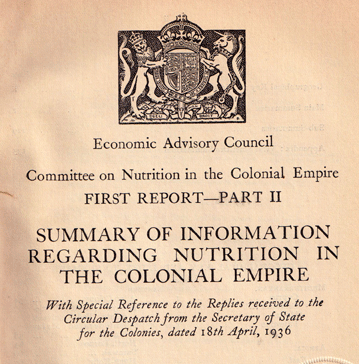
Say what you will about colonial empires, but at least they generate reports. I recently came across a British report to Parliament in 1939 entitled “Summary of Information Regarding Nutrition in the Colonial Empire.” Four pages are devoted to Aden Colony, which is said to have an area of 75 square miles, a population in 1931 of 45,992, a birthrate in 1937 of 32.07 per 1,000, an infant mortality rate in 1937 of 196.61 per 1,000, and a death rate in 1937 of 31.72 per 1,000. I attach excerpts below:
“1. General. – …This survey deals primarily with the 75 square miles of volcanic rock and sand which constitute the Colony of Aden; a detailed review of the nutritional affairs of the Protectorate has been postponed until a later date. The Colony is almost entirely urban and so cosmopolitan in make-up as to complicate the task of reviewing the nutritional conditions as a whole. Arabs, Jews, Somalis and Indians of various races predominate, and a preponderance of males is occasioned by the fact that those who come to Aden for varying periods of time to seek livelihood as coolies or tradesmen leave their womenfolk behind in the interior or in India. The natural division is to classify Arabs, Jews and the poorer classes of Indian Mohammedans as the indigenous population and it is to these, particularly the middle and lower classes, that the present nutritional considerations apply.
2. Composition and Nutritive Value of Dietary. – All the chief articles of diet are, with the exception of fish, imported from overseas or from Arabia. They are: rice, flour, sugar,; fish, mutton, beef, goat’s milk, eggs, ghee; fruits, vegetables, dates, lentils, simsim oil, tea, coffee and spices.
Rice, of varying quality but always milled, is imported from India and the East. It is the foundation of the mid-day meal at which it is eaten together with cooked fish or meat. Flour comes in large quantities from India and Australia. That used both by Indians and Arabs for chapatties is the Indian variety known at ‘atta’ which retains most of the essential parts of the wheat grain. White flour is used extensively for bread making. Jowari (Sorghum vulgare) is imported from the Protectorate and ground into flour; but its use is not so general as that of flours imported from overseas.
Of animal foods, fish is the most constant item, especially in the diets of Arabs and Jews. All varieties from sprat to shark abound in local waters. Mutton, imported from British Somaliland, is of excellent quality and has a high fat content. The bulk of imported beef is earmarked for ship chandlers; the local consumption (mainly by Jews) is small and scarcely merits attention. The supply of milk for the poorer classes is derived from goats which live in or around the dwelling houses. Cows’ milk is also sold, but it is relatively expensive and insufficient in quantity to meet the needs of the whole population even if they could afford it. There is a certain amount of goat’s ilk available, but the supply and quality vary with the amount of green fodder available. Owing to frequent scarcity of green fodder (which is procured from the interior) the goat has to rely on poor quality hay supplemented with such extras as it can pick up in the streets and off garbage heaps. Mainly, it is thought, as a result of missionary education, the custom has developed of boiling all milk given to children. This may provide a much needed safeguard against bacterial contamination, but the question arises whether or not its nutritive value may be unduly impaired in the process. The consumption of milk per caput is small.
Vegetables, mostly fo the European type, are produced in the garden owned and controlled by the settlement and are retailed in the markets to the public. Pumpkins, water melons, cucumbers, spinach, bringals, lady’s fingers, cress, tomatoes, potatoes, onions and various herbs are usually available and are cooked as a separate evening dish or added to fish and mutton dishes. Dates are not a regular dietary item in the average Arab family, but are largely consumed by the coolie class and by Somalis.
In general, the dietetic régime would be fairly sound if adequate quantities could be guaranteed for all. Unfortunately, however, quantitative deficiency in the poorer classes is a serious consideration. As the social scale descends the diet becomes quantitatively and qualitatively poorer, a fact which is reflected in the extent of deficiency disease in the poorer classes, particularly among children.”
to be continued